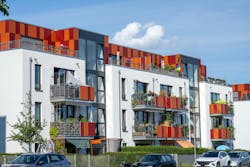The Smart Money: MDU Technology Overview
This article originally appeared in the August 2024 issue of Security Business magazine. Don’t forget to mention Security Business magazine on LinkedIn and @SecBusinessMag on Twitter if you share it.
Multifamily properties are increasingly investing in smart building solutions to improve operations, reduce costs, and better attract and retain tenants. Access control, energy, and water solutions significantly impact multifamily living by enhancing efficiency and sustainability, leading to reduced utility costs and environmental benefits as well as significant operational savings.
Properties and building owners must strategically determine where to invest resources to maximize returns, making it essential to identify areas with the highest potential for return on investment (ROI). Understanding which technologies, projects, or initiatives deliver the most significant financial and operational benefits allows businesses to allocate their budgets effectively, drive growth, and maintain a competitive edge.
Parks Associates' recent custom research with SKBM reveals the impact of new tech in multifamily housing.
Electronic Access Control and Smart Door Locks
Electronic access control systems are increasingly commonplace across the multifamily housing market. These systems, unlike a mechanical lock and key system, use electronics and digital networks to control access, commonly including control points such as base building doors and gates to the parking lot or garage. They may additionally include buzzer boxes or intercoms and, increasingly, smart door locks on residential units.
Participants reported a 20% efficiency boost for maintenance staff by not needing to pull keys, a 3% reduction in the CAPEX operational budget due to not needing to replace doors and locks.
Smart door locks on residential units provide MDUs with several direct and indirect cost savings and additional functionalities. Participants reported dramatic efficiency boosts for their maintenance teams as well as direct savings from no longer needing to replace doors and locks. They were able to add new self-guided tour functionality, increasing close rates for residential units.
These benefits relied on integration into larger systems and platforms, including maintenance work order systems, resident-facing apps, and leasing platforms. Integration with the property management system (PMS) also allowed for automated resident turnover procedures, so that staff does not need to manually reprogram locks during the turnover process.
Features such as low battery warnings and automatic work order generation prevented possible issues such as resident lock-out.
Electronic access control systems that incorporate a gate or door controller to the base building or parking lot allow properties to reduce labor expenses and headcount, moving away from needing to support night shifts for concierge or doormen or eliminating the need for these roles entirely on select properties. Modern access control systems also support greater accountability through their record-keeping and audit trails, ensuring a higher degree of legal compliance and reducing liability. Participants with these systems also report reduced package theft, an additional benefit for residents.
Installing cellular intercoms and gate controllers provides an immediate ROI for companies impacted by the sunsetting of legacy telephone service – potentially cutting monthly costs by 75% or more.
Security at the Gate
Cellular intercoms and gate controllers offer a dramatic cost benefit to many multifamily properties, which are facing an immediate crisis in the retirement of plain old telephone service (POTS) lines, which have historically been used to operate existing buzzer and intercom solutions and enable access control functionality. Regionally, the price to operate these existing access control solutions has grown from 4x to 8x – costing companies potentially hundreds of thousands of dollars per month across their footprints.
Some POTS providers are also terminating service entirely, causing immediate operational challenges for MDUs that rely on this service for their access control. Companies are evaluating options, including upgrading their legacy equipment and transitioning to cellular connectivity where possible.
Smart Water Meters and Water Leak Detectors
Several types of water leak detection solutions are being adopted by multifamily properties. These solutions fall into two broad categories – smart water meters and separate water leak detection devices that act as sensors.
The impact of these solutions can vary widely, depending on the age of the building and the potential threat posed by water leaks. Parks Associates’ recent custom research with SKBM reveals that they reported the highest returns for water leak detectors in portfolios including older properties – built before 2000 – and high-rise buildings.
Older properties are the most likely to have water leaks, with slow or unnoticed seeping from plumbing or running of toilet fixtures resulting in high water consumption and gradual damages from rot and mold.
In addition to overall water savings, there are potentially significant savings preventing water damage across portfolios. One study participant, with a portfolio of low-rise to mid-rise buildings of varying ages, reported that in just the first year of deploying water leak detectors, his company generated 452 leak-related work orders and prevented an estimated $35K in damages per incident across the 29 assets where leak detectors are currently deployed.
Within high-rise buildings, water leak detection systems paired with automatic shut-off valves have the potential to save hundreds of thousands or even millions of dollars in damages in a single asset. Within this type of property, burst pipes and similar adverse events can impact upwards of sixty or more units – causing widespread damage to the building and to residents’ belongings. Automatic shut-off valves minimize this damage, while the detection systems mobilize property staff for a rapid response.
The impact on insurance premiums was mixed. Properties with a history of water leaks experienced easier negotiations with insurers. For newer properties and properties without a history of leaks, water leak detection solutions were occasionally required by insurers and/or helped to mitigate the effects of rate hikes. However, many multifamily companies are moving to larger deductibles per property, with $100K deductibles increasingly common. With relatively few leaks exceeding $100K in damages, this means that properties must increasingly bear the cost of water leaks themselves. For these properties, the ability to reduce damage from multiple smaller leaks has powerful cost savings and a direct impact on NOI.
Smart Thermostats and Smart Heating
While many companies see smart thermostats as primarily an amenity for residents, this technology offers many operational and cost-saving benefits. Smart thermostat solutions integrated into building management systems allow authorized personnel to automatically set temperature ranges, enabling property staff to control temperatures more easily in vacant units and in common areas. This provides a return on investment in the form of both labor and energy savings.
Participants report saving 18-20% of energy costs with deployment in common areas and vacant units. More advanced deployments incorporating time-of-use programs experienced still higher savings, with a 20-30% reduction in annual expenses and 20-30% reduction in energy use. Payback periods were between six months and two years.
In select markets, such as New York City, properties additionally pay to heat their residents’ units during the winter. They may additionally cover electricity, sewage, water, and gas. In these situations, smart thermostats paired with boiler controls and time-of-use electrical plans offer significant savings to properties. Beyond direct utility savings, energy-savings initiatives help companies meet Environmental Sustainability Goals (ESG) initiatives, marrying sustainability with a powerful business case that resonates with investors.
Depending on property location, smart thermostats can also play a key role in disaster prevention. There are many garden-style properties in the southern United States and other areas where sustained below-freezing temperatures are dangerous to plumbing running alongside the outer walls of residential units – with these freezes oftentimes causing burst pipes during winter months.
Smart thermostats can protect both occupied and vacant units, through low-temperature alerts tied to work order systems. In cases where residents may leave for vacation in the winter, turning the heating off or forgetting an open window, property staff can identify and correct heating issues before disaster strikes.
For vacant units, maintenance or other staff will often proactively set the thermostats to a suitable temperature to prevent pipes from bursting. In such a deployment scenario, smart thermostats save valuable staff time while also ensuring that no residential units are accidentally missed.
Smart Apartment Amenities
Smart apartment amenity packages – including features like smart thermostats and water leak detectors – are increasingly expected by residents, especially those living in Class A luxury buildings. These solutions are additionally expanding to serve more market segments, with growing penetration into Class B and Class C housing. In more competitive markets and for select demographics, these amenities may be necessary for prospective residents to consider renting at all.
Return on investment for smart apartment amenities varies. In select markets, these amenities may be necessary for residents to consider renting at all. In others, they may result in lifts to rent ranging from 5-10%. These solutions commonly have a three-year payback period.
The exact contents of smart apartment amenity packages vary, but smart thermostats are a highly popular component. Other components include solutions such as smart lighting controls, video doorbells, and smart appliances – which can offer their own efficiencies. Rent is only one way of measuring smart apartment amenity effectiveness.
About the Author

Kristen Hanich
Kristen Hanich is Director of Research for Parks Associates. https://www.parksassociates.com
